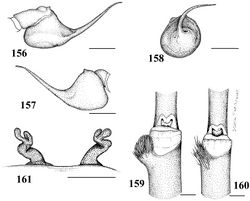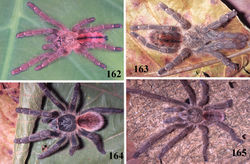Iridopelma oliveirai
| Notice: | This page is derived from the original publication listed below, whose author(s) should always be credited. Further contributors may edit and improve the content of this page and, consequently, need to be credited as well (see page history). Any assessment of factual correctness requires a careful review of the original article as well as of subsequent contributions.
If you are uncertain whether your planned contribution is correct or not, we suggest that you use the associated discussion page instead of editing the page directly. This page should be cited as follows (rationale):
Citation formats to copy and paste
BibTeX: @article{Bertani2012ZooKeys230, RIS/ Endnote: TY - JOUR Wikipedia/ Citizendium: <ref name="Bertani2012ZooKeys230">{{Citation See also the citation download page at the journal. |
Ordo: Araneae
Familia: Theraphosidae
Genus: Iridopelma
Name
Iridopelma oliveirai Bertani, 2012 sp. n. – Wikispecies link – ZooBank link – Pensoft Profile
Diagnosis
The male differs from those of all other species by very long leg I (leg IV/I length = 0.73) (Fig. 165). The female resembles Iridopelma hirsutum by diverging spermathecae folded distally (Fig. 161), but differs by having a grayish carapace and legs and lacking an abdominal pattern (Fig. 164).
Etymology
Specific name is a patronym in honor of Judge João Carlos Sá Moreira de Oliveira, for allowing the author to have access to part of the aviculariine specimens deposited in the Instituto Butantan collections, which were fundamental for the completion of this present work.
Types
Holotype male (IBSP 10100), Brazil, state of Bahia, Central, Toca dos Pilões [11°08'S, 42°06'W], A. D. Brescovit, July 2000, and paratype female (IBSP 8714), at night in “Macambira” bromeliad (Bromelia laciniosa), same data.
Additional material examined
Only the types.
Description
Holotype male (IBSP 10100). Carapace 14.7 long, 12.7 wide, chelicerae 7.1. Legs (femur, patella, tibia, metatarsus, tarsus, total): I: 16.5, 7.9, 16.7, 17.8, 7.9, 68.8. II: 14.3, 7.3, 13.4, 14.4, 6.1, 55.5. III: 10.8, 5.6, 9.0, 10.2, 4.4, 40.0. IV: 13.1, 6.2, 12.1, 13.4, 4.8, 49.6. Palp: 9.1, 5.1, 6.9, –, 2.4, 23.5. Mid-widths (lateral): femora I –IV = 2.5, 2.4, 2.3, 2.3, palp = 1.8; patellae I–IV = 2.5, 2.4, 2.3, 2.4, palp = 1.9; tibiae I–IV = 1.9, 1.9, 1.9, 2.0, palp = 1.7; metatarsi I–IV = 1.3, 1.2, 1.2, 1.2; tarsi I–IV = 1.1, 1.2, 1.4, 1.5, palp = 1.6. Abdomen 12.8 long, 6.1 wide. Spinnerets: PMS, 1.1 long, 0.5 wide, 0.2 apart; PLS, 1.7 basal, 1.1 middle, 1.6 distal; mid-widths (lateral), 1.1, 0.9, 0.7, respectively. Carapace: length to width 1.16. Fovea: deep, 2.0 wide. Eyes: tubercle 0.9 high, 1.8 long, 2.5 wide. Clypeus 0.8. Anterior eye row procurved, posterior straight. Eye sizes and inter-distances: AME 0.4, ALE 0.5, PME 0.3, PLE 0.5, AME–AME 0.6, AME–ALE 0.3, AME–PME 0.2, ALE–ALE 1.6, ALE–PME 0.5, PME–PME 1.5, PME–PLE 0.1, PLE–PLE 1.9, ALE–PLE 0.5, AME–PLE 0.5. Ratio of eye group width to length 1.9. Maxillae: length to width: 2.0. Cuspules: 90–100 spread over ventral inner heel. Labium: 1.4 long, 2.3 wide, with ca. 40 cuspules. Labio-sternal groove deep, flat, with two sigillae. Chelicerae: basal segments with eleven teeth decreasing in size from distal to basal portion. Sternum: 6.6 long, 5.0 wide. Sigilla: not evident. Legs: leg formula: I II IV III. Scopula: tarsi I–IV fully scopulate. Metatarsi I–II 4/5 fully scopulate; III 3/4 distal scopulate; IV 1/2 distal scopulate. IV divided by three wide row of setae. Tibial spurs. Legs: I, single, 2.0 long, 1.2 wide, with numerous spiniform setae on its tip (Fig. 159); II, single, without elevation, formed by numerous spiniform setae (Fig. 160). Urticating hairs type II (0.73 to 0.77 long, 0.015 wide) on abdomen dorsum. Palp: embolus 2.2 long, with 105° curvature to retrolateral side. Embolus basal, middle and distal width of 0.2, 0.1 and 0.03, respectively. Tegulum 1.2 long, 1.5 wide. (Figs 156–158). Cymbium: Spiniform process 0.6 long, 0.5 wide on apex. Color pattern: carapace, chelicerae, legs and palps brown with light brown setae. Sternum, labium, maxillae and anterior half of coxa I black. Posterior half of coxa I and coxae II–IV brown with light brown setae. Longitudinal stripes on dorsum of femora, patellae, tibiae and metatarsi whitish. Distal femora, patellae, tibiae and metatarsi with white rings. Tarsi with dorsal “U” shaped orange stripe. Abdomen dorsum brown with long light brown setae. Ventrally black (Fig. 165).
Description
Paratype female (IBSP 8714). Carapace 13.2 long, 11.4 wide, chelicerae 6.7. Legs (femur, patella, tibia, metatarsus, tarsus, total): I: 11.0, 6.2, 8.6, 8.0, 4.6, 38.4. II: 9.7, 5.8, 7.6, 7.1, 4.0, 34.2. III: 8.3, 4.8, 5.9, 6.3, 3.8, 29.1. IV: 10.2, 5.2, 8.6, 8.8, 4.0, 36.8. Palp: 7.4, 4.2, 5.0, –, 5.1, 21.7. Mid-widths (lateral): femora I –IV = 2.0, 2.0, 2.3, 2.1, palp = 1.8; patellae I–IV = 2.2, 2.1, 2.1, 2.2, palp = 2.0; tibiae I–IV = 2.0, 1.8, 1.8, 2.1, palp = 1.8; metatarsi I–IV = 1.7, 1.5, 1.5, 1.2; tarsi I–IV = 1.8, 1.7, 1.8, 1.5, palp = 1.9. Abdomen 13.2 long, 8.8 wide. Spinnerets: PMS, 1.6 long, 0.9 wide, 0.2 apart; PLS, 1,8 basal, 1.3 middle, 1.8 distal; mid-widths (lateral), 1.3, 1.1, 0.8, respectively. Carapace: length to width 1.16. Fovea: 2.4 wide. Eyes: tubercle 0.7 high, 1.6 long, 2.3 wide. Clypeus 0.4. Anterior eye row procurved, posterior slightly recurved. Eye sizes and inter-distances: AME 0.4, ALE 0.4, PME 0.4, PLE 0.4, AME–AME 0.5, AME–ALE 0.2, AME–PME 0.5, ALE–ALE 1.7, ALE–PME 0.5, PME–PME 1.4, PME–PLE 0.1, PLE–PLE 1.8, ALE–PLE 0.5, AME–PLE 0.5. Ratio of eye group width to length 2.1. Other characters as in male, except: maxillae: length to width: 1.8. Cuspules: 100–150 spread over ventral inner heel. Labium: 1.5 long, 1.9 wide, with ca. 50 cuspules. Labio-sternal groove deep, narrow, with two sigillae. Chelicerae: basal segments with thirteen teeth decreasing in size from distal to basal portion. Sternum: 5.8 long, 5.1 wide. Legs: leg formula: I=IV II III. Scopula: tarsi I–IV fully scopulate. Metatarsi I–II fully scopulate; III 2/3, IV 1/2 distal scopulate, IV divided by three wide row of setae. Urticating hairs type II (0.57 to 0.61 long, 0.015 wide) on abdomen dorsum. Genitalia: paired diverging spermathecae tapering from base to apex, folded medially, with strong distal constriction forming two distal lobes (Fig. 161). Color pattern as in male, except: carapace, chelicerae, legs and palps grayish with pinkish setae; patellae and tibiae of palps and legs I–II and tibiae and metatarsi of leg III ventrally dark. Sternum, labium, maxillae and coxae black. Abdomen dorsum brown with long pinkish setae.
Distribution
Brazil: known only from Central, State of Bahia (Fig. 169).
Natural History
Little is known regarding this species. The vegetation in Central, state of Bahia, comprises mainly caatinga (a xerophilous vegetation). One female was found at night in a bromeliad (Bromelia laciniosa).
Color pattern ontogeny
Data for small juveniles is lacking. Large immatures specimens have a pattern similar to Iridopelma hirsutum (Figs 162–163). Adult male and female lack or have a very inconspicuous abdominal pattern (Figs 164–165).
Original Description
- Bertani, R; 2012: Revision, cladistic analysis and biogeography of Typhochlaena C. L. Koch, 1850, Pachistopelma Pocock, 1901 and Iridopelma Pocock, 1901 (Araneae, Theraphosidae, Aviculariinae) ZooKeys, 230: 1-94. doi
Images
|


